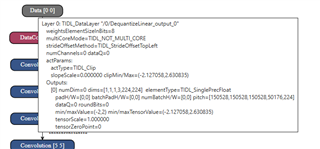Tool/software:
I have developed a sequence model that does not use images as input.
Therefore, the network input is in float format.
However, TI's default deep learning architecture is designed for image-based models.
To input float values into the model in this environment, I used the following method:
I checked the range of the input values and normalized them to fit within the range of 0 to 255.
For example, if the range of the input float values is 0 to 1, I set the std in the conversion settings to 1/255.
Then, in the C code, I multiplied the input float values by 255 before feeding them into the network.
This works correctly because the std of 1/255 was applied in the configuration (cfg).
However, the 8-bit representation did not meet the range requirements of my float input because the maximum expressible value with 1/255 is limited.
Please let me know if there is any way.


